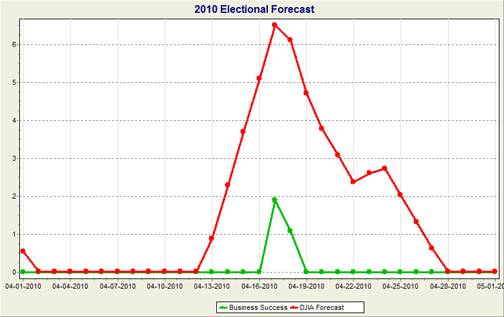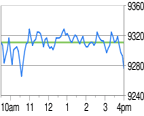The
term “TAO” refers to the “Technical
Aspect Oscillator”, as well as the cycles and balance
of yin and yang in the ancient and enduring Chinese philosophy—Taoism.
The formula used to make the forecast is based on a weighting of
planetary
angular separation developed by myself and is based on the effects
of astrological aspects including what many astrologers regard as
minor aspects. The Tao DJIA Forecast draws from the theory of harmonics
introduced by John Addey.
The Tao forecast uses a number of integrated and innovative
concepts in astrological forecasting, one of which
is exponential summation.
Exponential
summation, as used by the Tao DJIA Forecast, provides a way
for astrological influences to leave a long-lasting effect
that combines with ongoing astrological influences.
Example: suppose that there is a trine aspect between two planets
and this aspect results in a forecast of a higher predicted DJIA
score. When the trine aspect is out of orb there may be a long-lasting
effect from the trine aspect. The harmony, optimism, or other
qualities that may be associated with the aspect are theorized
leave a lasting
effect that does not completely disappear when the aspect is
out of traditional orb.
Exponential
summation is a mathematical procedure that implements the
concept of long-lasting effects from influences that are relatively
short in duration. There are other reasons why researchers
may wish to use exponential
summation but this is its primary use in the TAO DJIA Forecast.
Exponential
summation is calculated using several parameters which
can be adjusted in order to affect
the strength and duration of the relatively long-term effects of
the astrological influences. These parameters are the exponential
summation percent, scaling factor,
and adjustment to the basic daily TAO raw scores.
One
of my primary areas of research over the last 25+ years
has been to refine
and advance the original work of Donald Bradley and his
Siderograph. The
development of the TAO (technical aspect oscillator) is the preliminary
result of those
efforts (please consult the scientific abstract).
The TAO has
planetary angular separations as the sole input into strictly
mathematical formulae,
with the TAO numbers as the output. The raw daily output is
transformed mathematically
into
a zeroed oscillator. The scientific and mathematical claim
is that the TAO correlates with global human psychology,
as measured by
the rise and fall
of the global
stock market indices. This has been validated to greater than
1:10,000 against chance.
David
Cochrane, of Cosmic Patterns, www.astrosoftware.com,
and I have released the TAO DJIA Forecast
program that discloses
the
composition
of the TAO.
This module is as user friendly as it can be,
and enables everyone to duplicate the disclosed TAO formulation,
and
to explore
and to develop
their
own TAOs for selected and specific applications.
The TAO DJIA Forecast is a Flexible and Objective Astrological
Research Tool, with 5 primary adjustable components:
1.
The TAO Aspectarian: It assigns positive and negative numeric
values
to every degree
of planetary angular separation, 0 degrees
through 180 degrees. And if the separation is, for example, 240
degrees, then its value becomes equal to that of 120 degrees
(360 – 240
= 120). These values are disclosed in one of the displayed results
features. The TAO aspectarian is itself zeroed. That is, when
all of the numeric values assigned to the planetary angular
separations,
0 through 180 degrees, are summed, the total equals zero. These
TAO aspectarian values can be changed through the pertinent file.
2.
Selected planetary pairs: Moon’s North Node
(MNN)/Mars, MNN/Jupiter, MNN/Saturn, Mars/Jupiter, Mars/Saturn,
Sun/Jupiter,
Mercury/Jupiter, Venus/Jupiter, and Venus/Mars. These are the
9 planetary pairs. These pairs can be changed through the
applicable file.
3.
Planetary pair weightings: MNN/Mars 0.5, MNN/Jupiter
0.5, MNN/Saturn 0.5, Mars/Jupiter 0.5, Mars/Saturn 0.5, Sun/Jupiter
0.2, Mercury/Jupiter
0.2, Venus/Jupiter 0.2, and Venus/Mars 0.2. Therefore, for
example, if on a given day the angular separation of Mars/Jupiter
gives
an aspectarian value of 14, then the weighted value for the
day is 14x0.5=7. If Venus/Mars value is -15, then its value
for the
day is -15x0.2 = -3. These weights can also be changed through
their file.
4.
TAO DJIA Forecast zeroing: The Sirius 1.1 TAO DJIA
Forecast has added a default of +4 to every daily value obtained.
This is to compensate for planetary orbital factors, and
the selected
pairs.
If different weights and/or planetary pairs are selected,
then careful attention must be given to how close the TAO
average
remains a zeroed oscillator. The +4 default may have to
be
adjusted higher
or lower. Zeroing is a critical function within the TAO
DJIA Forecast, and is necessary for finding valid scientific
correlations.
5.
Exponential, Scaling, and Adjustment Factors:
• The % factor is the selected exponential moving average.
• The higher the % factor is set, the quicker the moving average.
• The default is set at 2% for the Quick, and 1% for the Slow.
• Scaling. Both the Quick and the TAO DJIA Forecast are set to 100.
• The Slow is set to 10.
• The adjustment is set to +4, for the nine selected planetary pairs.
On
every given date, the parameters used are listed below the
calculated data. Both exponential averages can be changed,
and the higher the selected
%, the shorter the exponential moving average. The TAO DJIA Forecast
will respond faster to new daily data.
The
scaling factor is also important for the end result:
The
Slow TAO
guides the longer term trend of the TAO DJIA Forecast
the most. As a default the
Slow TAO is set to 10, and, in contrast both the Quick
and TAO DJIA Forecast are
set to 100. The
Quick and TAO DJIA Forecast (average of the Quick and Slow
TAO) are best set to the same parameters.
All of the parameters
are adjustable. These
are the five primary inputs and parameters needed
to create the Raw, Quick, Slow and TAO DJIA numbers
and graphs.
David and I
welcome
feedback
on the TAO DJIA Forecast module. Your observations
will help us to improve it.
Thank you for your interest.
SCIENTIFIC ABSTRACT
TAO Correlations with Global Stock Market Indexes
OVERVIEW: This study found a statistically significant correlation
between the TAO average and the Dow Jones Industrial and SP 500 stock
market
indexes, to greater than 1:10,000 against chance during the time
period tested,
from 1/1/1999 through 08/14/2009. The TAO average is a mathematical
oscillator with
known planetary longitudinal, angular separations as the sole input.
It is inherently and strictly mathematical, and thus has the potential
to
be scientifically
useful, across many diverse applications. The TAO research is theorized
here to be a factor interrelated with global human psychology, using
the measure
of the rises and declines of stock market prices.
ORIGIN: The TAO average originated from:
- 1) Studies of the mathematician and astrologer Donald Bradley, who
first developed his Siderograph that evaluated planetary
angular
separations using both an
objective aspectarian and subjective
planetary evaluations and applied it to the movements of the
stock market
- 2)
The work of Sherman McClellan, a mathematician and technical
stock market analyst who
invented the McClellan Oscillator
and Summation
Indexes—both
stock market analytical, technical
trading tools.
- 3)
Psychological contrarian sentiment
indicators that became popular in
the 1970’s and 1980’s,
measuring the percentage of investment
advisors who are either bullish
(positive, expecting
rising stock prices) or bearish
(negative, expecting falling stock prices).
METHODOLOGY: The TAO average is comprised
of five primary integrated concepts and methodologies.
The
primary foundation for this work is the aspectarian,
that assigns positive and negative
numeric values to every degree of planetary angular
separation (similar to Bradley), and
is derived from
the numbers
2 and 3 and their harmonics (similar
to the harmonic theories of
John Addey, and different from Bradley).
• First, the harmonics forming the aspectarian are logarithmically weighted
to be mathematically and logically consistent,
and possibly integrated with current physics, especially string or fractal
theory.
• Second, only selected planetary pairs are used (unlike Bradley), both
because of the nature of the comparison to
the stock market and its psychology, and planetary periodicity.
• Third, these selected pairs are weighted, related to orbital and periodicity
factors (also unlike Bradley).
• Fourth, for the given time period, the raw TAO oscillator is zeroed,
so that the summation of all the raw TAO
values equals zero, (similar to McClellan, and a critical component of his oscillator.)
This step
compensates
for planetary
orbital idiosyncrasies in relationship to
the aspectarian
and for the particular time frame of the study. Zeroing is critical for
mathematical and scientific
evaluation of correlations.
• Fifth, the zeroed raw TAO values are then both averaged (Quick TAO) (similar
to the McClellan Oscillator) and summed (Slow TAO) (like the McClellan Oscillator’s
summation index). The TAO average is the average of the Quick TAO and the Slow
TAO. The summation provides an insight into human psychology as reflected in
the TAO average interrelating with the buying and selling of stocks over a period
of time—a sum of the thoughts and actions
of people over longer time intervals.
NULL
HYPOTHESIS: There is no correlation between the TAO average and
two of the
global stock
indexes, the Dow Jones Industrial
Average and the SP
500 Index.
RESULTS:
Since the TAO average is a known quantitative variable, stock
prices are
another known quantitative
variable, and they are independent,
then it
is statistically indicated
to apply
a standard correlation test
for two independent variables:
The
Pearson Product-Moment Correlation. For the
Tuesday and Friday
data points for both
the TAO average and the DJIA and SP 500 indexes, from
1/1/1999
through 08/14/2009:
n=1108, the Pearson r for DJIA, r
= +0.67; for SP 500,
r = +0.76. Therefore, the Null Hypothesis is rejected at
greater
than
1:10,000 against
chance, using the Dow Jones Industrial Average and SP 500
as comparative,
objective measures.
RESEARCH
IMPLICATIONS:
There
is a need for duplication
of this research by an
independent
investigator, and
this is now possible with the
publication of the
computer software formatted for the
TAO DJIA Forecast,
optional report option
for Sirius 1.1.
TAO
DJIA FORECAST: This
software not only reveals the composition of the TAO,
but also allows
users to verify the parameters
and results,
and to modify the parameters according to
their own
specifications
and insights.
The
TAO has research potential for further investigation
in the
subjects of financial, natal, medical,
mundane,
and political/social astrology. Also,
transits, angles (Ascendant,
Midheaven,
Vertex, etc.), progressions, directions, zodiacs,
hypothetical
planets (Uranian, Jaynian, etc.), asteroids,
eclipses
and ingresses, and more,
can also
now be objectively and scientifically
studied.
The
Aspectarian generated for the TAO verifies some fundamental
tenets
of
traditional astrological aspect
analysis (trine beneficial, opposition
detrimental,
etc.).
Further research is needed. For the first time
in astrological
history,
a basic foundation for quantitative and scientific
experimentation
has been created from the objective
and quantitative
TAO aspectarian.
There
are, literally, an infinite
number of Technical Aspect
Oscillators.
The TAO DJIA Forecast is only
one of them.
This TAO is a progressive
first
step toward
an empirical astrological research
methodology.
The TAO
DJIA Forecast, as it correlates
with
human activity, is applied
mathematics
and
astronomy. The TAO,
fundamentally, is mathematical
and
astronomical. As such,
it is applied
astronomy,
with
significant astrological
implications. With
the
current
measure being used, the
Tao
DJIA Forecast correlates with
the
global
stock indexes,
and that makes it useful
in
a tangible way.
The avenues
for
future research
are
virtually unlimited.
SAMPLE
PRINTOUT:

AUTHOR: Richard Schulz
|

![]() TAO
FJIA Forecast by Richard Schulz
TAO
FJIA Forecast by Richard Schulz